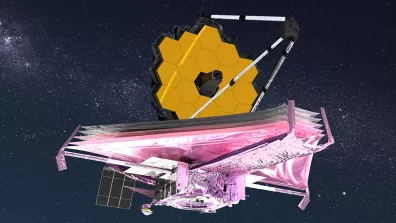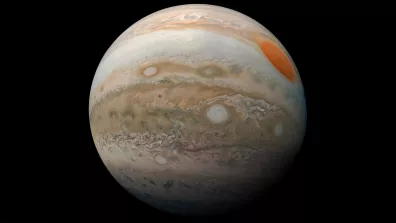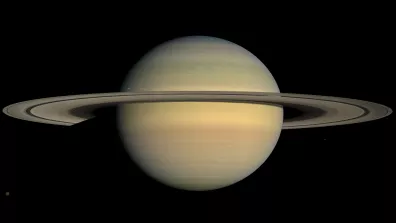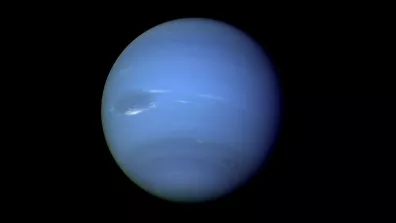Lying nearly three billion kilometres from the Sun, Uranus is the coldest planet in our solar system. At that distance, exploring it is fraught with difficulties... So, what do we know about this faraway world?
Fast figures
| Distance from Sun | 2.87 billion km |
| Volume | 6.833 × 1013 km3 (63 Earths) |
| Mass | 8.681 × 1025 kg (14.5 Earths) |
| Diameter | 51,118 km (four times wider than Earth) |
| Gravity | 90% that of Earth’s |
| Axial tilt | 97.8° |
| Revolution period | 84 Earth years |
| Rotation period | 17 hrs. 14 min. |
| Temperature | –224°C at cloud tops |
| Known moons | 13 |
The coldest planet
Of the eight planets in our solar system, Uranus is the seventh from the Sun. This distant world, composed of gas, has some surprising features.
- Gas or ice planet?
Uranus is an ice giant, as opposed to the gas giants—planets consisting entirely of gas, mainly hydrogen and helium—like Jupiter and Saturn. But don’t think for a minute that you could walk on it, as neither gas giants nor ice giants have a solid surface.
Uranus also contains ammonia, methane and water in icy form, albeit very different from the ice cubes we put in drinks “on the rocks”. Here, the term “icy” refers to substances that solidify at low temperatures but may be liquid or gaseous at higher temperatures. The planet has a diameter of 50,724 kilometres, four times wider than Earth, and it could contain 63 Earths. Its composition and size thus place it in the sub-category of ice giants.
Uranus has a solid internal structure composed of layers that become hotter and denser with depth. At its deepest point lies its core, nearly twice as dense as Earth’s. The temperature of 4,700°C here may sound impressive, but it’s in fact quite cold for a planetary core. By comparison, Neptune’s core is at about 8,000°C and Saturn’s 11,700°C. It’s the temperature of Uranus’ core and its distance from the Sun that make it the coldest planet in our solar system. Brrrrr!
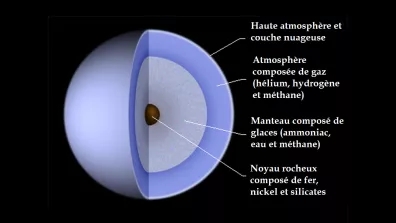
The core is surrounded by a mantle 10,000 kilometres thick, composed of hot and dense fluids consisting of ammonia and methane, sometimes called a “water-ammonia ocean”. These are the “ices” in their liquid state due to the very high temperature and pressure. It’s thought that it could be raining diamonds in the mantle! This is because when methane is subjected to intense pressures (here 200,000 times higher than in Earth’s atmosphere), it releases carbon molecules, and these molecules could form diamonds raining inside the planet.
The climate in the planet’s gaseous outer layers is extreme, with winds blowing at speeds up to 900 km/h, bright clouds and dark spots. It’s also in this upper atmosphere that temperatures reach record lows of –224°C… somewhat cold for anyone who might want to venture there.
- The sideways planet
Uranus is the only planet in our solar system—with Venus—to have such a pronounced axial tilt with respect to its orbital plane. Its axis is inclined 97.8°, so that it appears to spin sideways, orbiting the Sun like a “rolling ball”. This feature explains the planet’s unique climate and seasons. Uranus completes one orbit of the Sun in 84 Earth years, with summer and winter at each pole lasting 20 years. The poles are thus at once the hottest and coldest regions of the planet, creating extreme temperature swings.
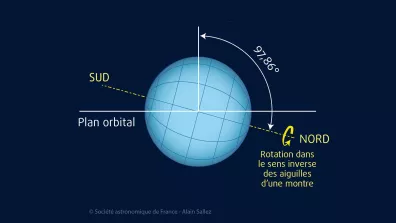
Scientists aren’t sure why Uranus is tilted this way. It could be the result of a young planet hitting it several billions of years ago, or it might once have been surrounded by a very massive ring, causing it to wobble on its axis like a spinning top.
Around Uranus
At the outer edges of the solar system, Uranus is not alone: it’s surrounded by a cortege of moons and rings.
- Small moons
There are 28 moons orbiting Uranus. These natural satellites are relatively small compared to other moons in the solar system. Most of them are less than 100 kilometres across, 17 times smaller than Earth’s Moon. But five of them—Miranda, Ariel, Umbriel, Titania and Oberon—are considered “major” and exhibit very varied features. Titania, the largest, is shaped by gigantic gorges and cliffs, its largest canyon extending across half of its surface from the equator to the south pole. Oberon has a dark, reddish and heavily cratered surface, while Umbriel also has numerous craters, one of which has a bright ring of material on its floor, possibly a mysterious deposit of ice.
- Planetary rings
Like all giant planets, Uranus has rings. They’re particularly dark and therefore harder to see than Saturn’s, for example. There are 13 such rings, composed of rock and dust particles that may have come from moons shattered by high-speed impacts millions of years ago. The rings are held around Uranus by the gravity of natural satellites called shepherd moons. For example, the moons Cordelia and Ophelia act on the main Epsilon ring, the brightest and furthest from the planet.
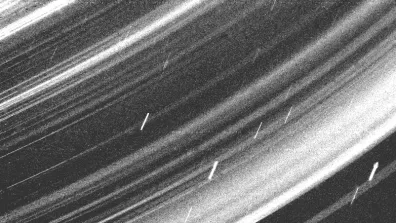
A largely misunderstood planet
Uranus is not visible from Earth with the naked eye. We therefore had to wait until the first telescopes appeared to observe it. Today, we still have few opportunities to get close up.
- Observation
Until the 18th century, Uranus was considered a star. It was the observations of William Herschel, an amateur astronomer, that led to its reclassification as a planet in 1781. He discovered Uranus with a hand-made telescope constructed with a mirror that he polished himself. His work pushed the boundaries of our solar system, which until then extended no further than Saturn—a huge leap forward for science.
- Exploring Uranus: mission impossible?
Voyager 2 is the first and last space probe to fly by Uranus, after its launch in 1977 by NASA to explore our solar system. On its closest approach to the planet in 1986, the probe was able to study the composition of its atmosphere and its unique climate. It also found ten new moons and two more rings. Since then, only ground-based telescopes and space telescopes like Hubble and James Webb, have observed it. The data gathered by Voyager 2 and our astronomical observations constitute most of what we know about Uranus.
Today, we may have the technical capability to send spacecraft to Uranus, but such a far-flung and ambitious mission would be very costly and complex. Projects to explore it have been envisioned, but soon shelved. Scientists are increasingly voicing their support for the scientific value of exploring Uranus, notably to obtain more insights into how planets formed. NASA envisions the Uranus Orbiter & Probe mission to explore the ice giant in the 2030s, arriving in around 2040. But for now, it remains—with Neptune—the least known planet in our solar system.
Quizz
A science team studying the atmosphere of Uranus discovered that it has a quite particular smell. What do you think it is?



